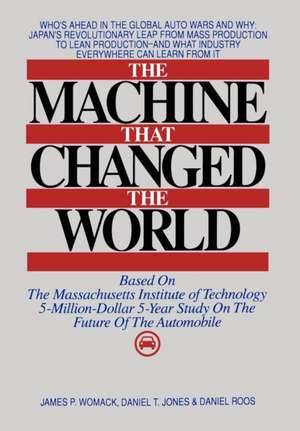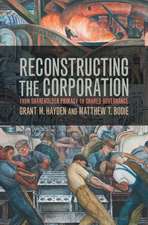Machine That Changed the World
Autor Daniel Roos, Massachusetts Institute of Technologyen Limba Engleză Hardback – 30 sep 1990
The Machine That Changed the World points for the first time to a positive way out of this dilemma. It shows that being defeatist about the Japanese threat, and tougher protectionism, are not the answers.
This book outlines the enormous tasks facing Western companies in the 1990s and has cogent messages for Japanese firms as well, as they move abroad.
The Machine That Changed the World is based on the largest and most thorough study ever undertaken in any industry: the Massachusetts Institute of Technology five-million-dollar, five-year, fourteen-country International Motor Vehicle Program's study of the worldwide auto industry.
Twice in this century the auto industry has changed our most fundamental ideas about how to make things. Now it is doing it again. Just as mass production swept away craft production, so a new way of making things, called lean production, is now rapidly making mass production obsolete.
Lean production is the Japanese secret weapon in the industrial wars and is spreading throughout the world. If Western companies and their managers and workers are to survive in the 1990s, they must learn and adapt to lean production. Some of the smartest already have begun to do so.
Lean production welds the activities of everyone from top management to line workers, to suppliers, into a tightly integrated whole that can respond almost instantly to marketing demands from consumers. It can also double production and quality, while keeping costs down. Its adoption, as it inevitably spreads beyond the auto industry, will change almost every industry and consequently how we work, how we live, and the fate of companies and nations as they respond to its impact.
In clear and compelling terms, this book explains what lean production is, and its global implications for all of us.
Preț: 362.90 lei
Nou
69.44€ • 72.50$ • 57.47£
Carte în stoc
Livrare din stoc 24 februarie
Specificații
ISBN-10: 0892563508
Pagini: 336
Dimensiuni: 229 x 160 x 33 mm
Greutate: 0.68 kg
Editura: Scribner
Notă biografică
Daniel Roos, Ph.D. (in civil engineering, MIT), is Director of the International Motor Vehicle Program at MIT.
Descriere
Today, the industrial world is experiencing the most revolutionary change since Henry Ford's assembly line -- which forever changed the way things are made. Japanese companies are sweeping the world, as Western companies and governments struggle to find ways to emulate them.
The Machine That Changed the World points for the first time to a positive way out of this dilemma. It shows that being defeatist about the Japanese threat, and tougher protectionism, are not the answers.
This book outlines the enormous tasks facing Western companies in the 1990s and has cogent messages for Japanese firms as well, as they move abroad.
The Machine That Changed the World is based on the largest and most thorough study ever undertaken in any industry: the Massachusetts Institute of Technology five-million-dollar, five-year, fourteen-country International Motor Vehicle Program's study of the worldwide auto industry.
Twice in this century the auto industry has changed our most fundamental ideas about how to make things. Now it is doing it again. Just as mass production swept away craft production, so a new way of making things, called lean production, is now rapidly making mass production obsolete.
Lean production is the Japanese secret weapon in the industrial wars and is spreading throughout the world. If Western companies and their managers and workers are to survive in the 1990s, they must learn and adapt to lean production. Some of the smartest already have begun to do so.
Lean production welds the activities of everyone from top management to line workers, to suppliers, into a tightly integrated whole that can respond almost instantly to marketing demands from consumers. It can also double production and quality, while keeping costs down. Its adoption, as it inevitably spreads beyond the auto industry, will change almost every industry and consequently how we work, how we live, and the fate of companies and nations as they respond to its impact.
In clear and compelling terms, this book explains what lean production is, and its global implications for all of us.
Cuprins
Contents
ACKNOWLEDGMENTS
BEFORE YOU BEGIN THIS BOOK
1 THE INDUSTRY OF INDUSTRIES IN TRANSITION
THE ORIGINS OF LEAN PRODUCTION
2 THE RISE AND FALL OF MASS PRODUCTION
3 THE RISE OF LEAN PRODUCTION
THE ELEMENTS OF LEAN PRODUCTION
4 RUNNING THE FACTORY
5 DESIGNING THE CAR
6 COORDINATING THE SUPPLY CHAIN
7 DEALING WITH CUSTOMERS
8 MANAGING THE LEAN ENTERPRISE
DIFFUSING LEAN PRODUCTION
9 CONFUSION ABOUT DIFFUSION
10 COMPLETING THE TRANSITION
EPILOGUE
END NOTES
APPENDIXES
A INTERNATIONAL MOTOR VEHICLE
PROGRAM SPONSORING ORGANIZATIONS
B INTERNATIONAL MOTOR VEHICLE
PROGRAM RESEARCH AFFILIATE TEAM
C IMVP PROGRAM AND FORUM PARTICIPANTS
D IMVP PUBLICATIONS LIST
INDEX




















